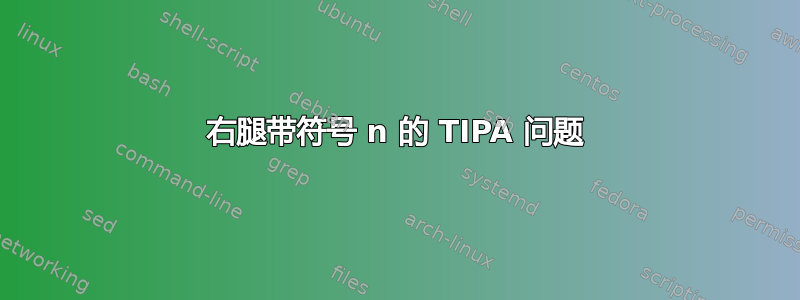
我可以用 TIPA 软件包输入所有符号,但用右腿输入不了 n。我通常使用\textipa{code of the symbol},它适用于我在 TIPA 手册中尝试过的所有代码,但不能用于\textnrleg。我甚至尝试从手册中复制单词然后输入,\textipa{}但不起作用。
\documentclass[12pt]{article}
\usepackage[ngerman]{babel}
\usepackage[a4paper, text={16.5cm, 25.2cm}, centering]{geometry}
\usepackage[sfdefault]{ClearSans}
\usepackage[utf8]{inputenc}
\setlength{\parskip}{1.2ex}
\setlength{\parindent}{0em}
\usepackage{tipa}
\usepackage[ampersand]{easylist}
\begin{document}
Grad der Öffnung
\begin{easylist}[itemize]
& semi-ouvert [\textipa{E}]
& [\textipa{Z}]
& [\textipa{K}]
& [\textipa{\textltailn}]
& [\textipa{\~E}]
& [\textipa{\textnrleg}]
\end{easylist}
\end{document}
答案1
答案2
该解决方案的 Unicode 版本(使用 lualatex 或 xelatex 编译)如下所示:
可以使用任何合适的 Unicode 字体。
例如,CMU Serif:
平均能量损失
\documentclass[12pt]{article}
\usepackage{xcolor}
\usepackage{fontspec}
\usepackage[ngerman]{babel}
\usepackage[a4paper, text={16.5cm, 25.2cm}, centering]{geometry}
%%\usepackage[sfdefault]{ClearSans}
\setmainfont{Noto Serif}
\newfontfamily\fipa{Noto Sans}[Colour=red]
\newfontfamily\fipab{CMU Serif}%'tipa font'
\newcommand\directipa[1]{{\fipa #1}}
\newcommand\mytilde{^^^^0303}
%\usepackage[utf8]{inputenc}
\setlength{\parskip}{1.2ex}
\setlength{\parindent}{0em}
%\usepackage{tipa}
\providecommand\XeTeXpicfile{ROSS, grmmble:-)}% with luatex that means "pretending" to be xetex just while you load the package
%https://tex.stackexchange.com/questions/357686/does-fontspec-no-longer-provide-the-textipa-command
\usepackage{xunicode}
\def\useTIPAfont{\fipa}
\usepackage[ampersand]{easylist}
\begin{document}
Grad der Öffnung
\begin{easylist}[itemize]
& semi-ouvert [\textipa{E}]; direct input = [\directipa{ɛ}]%\directipa for the font
& [\textipa{Z}]; direct input = [\directipa{ʒ}]
& [\textipa{K}]; direct input = [\directipa{ʁ}]
& [\textipa{\textltailn}]; direct input = [\directipa{ɲ}]
& [\textipa{\~E}]; direct input = [\directipa{ɛ^^^^0303}] or [\directipa{ɛ\mytilde}] or [\directipa{ɛ̃}]
& [\textipa{\textnrleg}]; direct input = [\directipa{ƞ}]
\end{easylist}
\newpage
\def\useTIPAfont{\fipab}
Grad der Öffnung
\begin{easylist}[itemize]
& semi-ouvert [\textipa{E}]
& [\textipa{Z}]
& [\textipa{K}]
& [\textipa{\textltailn}]
& [\textipa{\~E}]
& [\textipa{\textnrleg}]
\end{easylist}
\end{document}
附录
也可以使用直接输入,因为它已经是 Unicode 了。MWE 已经更新。







